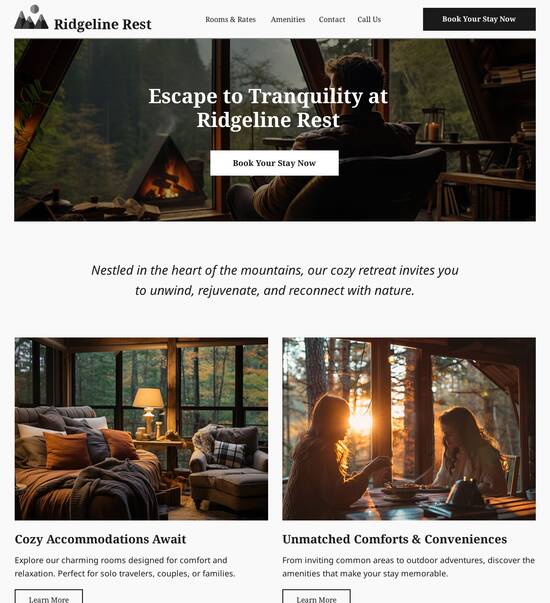
Website Template for Self Driving Car Companies
Explore Similar TemplatesAbout template
Create customized and effective landing pages quickly with Instapage's template designed for self driving car companies.
Recommended templates

Easy to build without coding
With the intuitive drag-and-drop builder, anyone on your team can create high-converting pages without any knowledge of code or design. Make enhancements to your landing page with custom widgets using Javascript, HTML/CSS, or third-party scripts.

Multiple layouts for any industry and goal
Select from 500+ landing page layouts built to boost conversions across industry-specific scenarios. Customize them by adjusting fonts, adding images, and generating on-brand content with the AI assistant. Quickly scale with Instablocks® and Global Blocks that you can save, reuse, and update globally.

Loads fast and looks polished on any device
Every template is responsive, which means they present professionally on any device and load blazingly fast with our Thor Render Engine. You can also power them up with Google AMP technology to deliver an unparalleled mobile experience and drive higher conversions.

Robust analytics & experimentation
Get real-time updates and reporting across all your devices, showing the number of visitors, conversions, cost-per-visitor, and cost-per-lead. Launch AI-powered experiments, run A/B tests, and use heatmaps to analyze user behavior, then optimize your landing page to maximize conversions.







Easy to build without coding
With the intuitive drag-and-drop builder, anyone on your team can create high-converting pages without any knowledge of code or design. Make enhancements to your landing page with custom widgets using Javascript, HTML/CSS, or third-party scripts.
Multiple layouts for any industry and goal
Select from 500+ landing page layouts built to boost conversions across industry-specific scenarios. Customize them by adjusting fonts, adding images, and generating on-brand content with the AI assistant. Quickly scale with Instablocks® and Global Blocks that you can save, reuse, and update globally.
Loads fast and looks polished on any device
Every template is responsive, which means they present professionally on any device and load blazingly fast with our Thor Render Engine.
Robust analytics & experimentation
Get real-time updates and reporting across all your devices, showing the number of visitors, conversions, cost-per-visitor, and cost-per-lead. Launch AI-powered experiments, run A/B tests, and use heatmaps to analyze user behavior, then optimize your landing page to maximize conversions.
All the features you need to build lead-generating landing pages
Explore more featuresLearn how to build top-performing landing pages for any goal
FAQs
Leading the way in building high-performing landing pages





An effective landing page template for self-driving car companies
Creating impactful landing pages is crucial for self-driving car companies looking to elevate their marketing strategy. Instapage offers a robust platform equipped with powerful templates designed to optimize your conversion rates and maximize ROI. By harnessing these innovative landing page designs, companies can attract leads effectively while showcasing their offerings in a market focused on technology and innovation.
Understanding the essentials of effective landing pages
An effective landing page serves as the first point of contact for potential customers, facilitating their journey toward understanding and engaging with your brand. Key elements of a successful landing page include:
- Clear value proposition: Articulate the unique benefits of your self-driving technology, ensuring visitors understand what sets you apart.
- Call-to-action (CTA): Create compelling CTAs that prompt users to take the next steps, whether it's signing up for a newsletter or requesting a demo.
- Responsive design: Ensure your landing pages are optimized for all devices, providing a seamless user experience regardless of where visitors access your content.
Integrating templates and lead generation elements
Utilizing Instapage's library of over 100 customizable templates allows self-driving car companies to quickly create landing pages that resonate with their target audiences. These templates include built-in lead generation elements that make capturing potential customers easy.
- High-converting form fields: Use optimized fields for lead capture that reduce friction and enhance user experience.
- A/B testing options: Experiment with different layouts, copy, and visuals to find the best performing configurations, ensuring ongoing optimization.
- Instablocks: Leverage reusable content blocks to create consistency across multiple landing pages, saving time and ensuring branding continuity.
Optimizing landing pages for conversion enhancement
Once your landing pages are live, continuous optimization is necessary to ensure they are performing at their best. Instapage offers powerful tools for this process.
- Analytics dashboard: Monitor visitor behavior and interactions with detailed metrics that guide your optimization efforts.
- Heatmap analysis: Understand where users are clicking and how they are navigating through your pages, allowing targeted improvements.
- Dynamic content: Personalize the user experience based on visitor data to increase engagement and conversion rates.
Incorporating these strategies will lead to higher engagement and ultimately drive results for your self-driving car company.
Ultimately, a well-designed landing page can significantly elevate your marketing efforts and enhance brand credibility within the self-driving sector. By leveraging Instapage's sophisticated tools, you can not only create effective landing pages but also continually optimize them for maximum impact.
Ready to supercharge your campaigns? Sign up for Instapage today and start building high-converting landing pages designed specifically for the unique needs of the self-driving car industry.
People also ask about Website template for self driving car companies
Website template for self-driving car companies
The evolution of digital presence for self-driving car companies
As the landscape of transportation technology transforms, self-driving car companies are beginning to recognize the importance of a robust digital presence. Having a dedicated website serves as the digital storefront, enabling businesses to showcase innovations, engage consumers, and build credibility in an evolving market. With more consumers relying on the internet for information and verification, a well-designed website template tailored to the self-driving car industry is crucial.
The paradigm shift: Why self-driving car companies need a dedicated web presence
The growth of autonomous driving technology has been significant, with investments pouring in from various sectors, including tech giants and automotive manufacturers. This increase in interest has created a pressing need for self-driving car companies to establish their online presence, a factor that can no longer be overlooked.
Establishing trust and credibility in an emerging market is essential for these companies. A dedicated website allows them to present their brand story and technological advancements while fostering consumer trust. Responding to concerns about safety, regulation, and reliability becomes easier within a structured digital framework.
Digital marketing strategies can significantly enhance a company's competitive advantage. By leveraging SEO, content marketing, and social media integration, companies can capture a larger audience. A well-structured website template becomes an indispensable tool for companies to inform potential customers and convert interest into sales.
Key features of an ideal website template for autonomous vehicle companies
An ideal website template for self-driving car companies needs to incorporate user-centric design that meets the technical complexity of the industry. Functionality is key here, and features must include integration with GPS and navigation APIs, which can dramatically enhance the user experience by providing real-time location and directions.
Real-time data display can also benefit users by showing vehicle statistics, safety alerts, and other information directly on their dashboard. This interactive approach keeps users engaged and informed, facilitating deeper connections with the technology.
Integration with GPS and navigation APIs
Real-time data display for users
Browser compatibility is crucial for ensuring universal access across different devices. Responsive design must be prioritized to ensure that users can seamlessly transition from desktops to mobile devices. Moreover, accessibility features must be integrated to accommodate users with disabilities, allowing everyone to access critical information about autonomous vehicles.
Engaging content: Communicating the future of transportation
Creating engaging content is vital for communicating the innovations in self-driving technology. Video marketing plays an essential role in this sector, allowing companies to effectively demonstrate their vehicles' capabilities. Educational videos that break down complex technology can help demystify autonomous driving for the average consumer.
Promotional footage can also be used to highlight the unique features of the vehicles. High-quality visuals can showcase the design and safety elements, providing a significant advantage in terms of customer engagement and conversion.
Educational videos explaining technology
Promotional footage showcasing vehicle features
Text content should also be strategically crafted to tell compelling narratives around innovations. Regular blog posts covering safety protocols and regulatory changes can position the company as a thought leader. Additionally, a comprehensive FAQ section can help address common customer concerns, creating transparency and building trust.
Visual appeal: Using colors and fonts to enhance branding
Visual elements significantly impact brand perception in the tech industry. Colors evoke emotions and can influence user behavior, making the choice of color scheme pivotal. For self-driving car companies, suggested palettes should reflect trust, safety, and innovation, with blues and greens often being effective choices.
Color psychology indicates that certain colors may increase consumer confidence in technology. Thus, companies must be strategic about their palette selection, ensuring it aligns with their brand identity.
Color psychology in the tech industry
Suggested palettes for trust and innovation
Typography also plays a vital role in conveying professionalism. Choosing fonts that are easy to read on digital devices can make a significant difference in user experience. Custom fonts can further enhance brand identity while ensuring clarity across all content types.
The functionality of a website template builder
A robust website template builder simplifies the design process with drag-and-drop capabilities that allow users to customize layouts effortlessly. This feature is instrumental for businesses without extensive coding expertise, enabling them to create stunning web pages without the need for a developer.
Pre-built layouts can significantly save time, allowing companies to maintain creativity without starting from scratch. Customization options enable businesses to tailor templates to their unique identity. For instance, changing header designs and organizing content blocks can enhance brand consistency.
Drag-and-drop capabilities: Simplifying the design process
Pre-built layouts: Saving time without sacrificing creativity
Customization options: Tailoring templates to company identity
Design elements that capture attention
The layout of a website holds significant importance as it creates visual hierarchy. Strategic use of white space can greatly enhance clarity and guide users' attention. A balanced approach to text and images can boost engagement and ensure information is effectively communicated.
Incorporating interactive elements such as parallax scrolling can elevate user experience. Utilizing animated icons and buttons can draw attention to critical features and call-to-actions, thereby enhancing engagement and encouraging exploration of the website.
Using white space to enhance clarity
Balancing text and images for engagement
Implementing parallax scrolling
Content management: Addressing common problems
To maintain a relevant digital presence, self-driving car companies must ensure that their websites feature fresh content. Regular updates inform potential customers of the latest innovations and developments within the company. Implementing a blog further supports ongoing engagement with audiences, providing a platform for news and insights.
Content Management Systems (CMS) enhance this process, offering ease of updates and streamlined publishing. This allows companies to focus on content quality rather than the technical aspects of web management.
Implementing a blog for ongoing engagement
Using CMS tools for easy updates
SEO optimization is equally vital for ensuring visibility. Integrating strategic keywords into the content strategy and optimizing meta tags enhance search rankings, driving more traffic to the website and allowing companies to reach a broader audience.
Using images to tell your company’s story
The principle of visual storytelling is especially essential for companies in the self-driving car sector. High-quality imagery can have a significant impact in conveying the innovation and sophistication of their offerings. Strong visuals can help narrate a company's journey, showcasing products, prototypes, and technology in an appealing manner.
Incorporating icons and infographics can also simplify complex information, making it accessible to a wider audience. Many users prefer visual content over text-heavy content, making thoughtful image implementation crucial for effective storytelling.
The impact of high-quality imagery
Image editing tools: Ensuring professional presentation
Incorporating icons and infographics: Simplifying complex information
Anticipating challenges and solutions
Technical glitches can undermine user experience, making usability testing a priority during the website development process. Ensuring that the website consistently functions across different devices and browsers is crucial for maintaining a positive user experience.
Moreover, with increasing concerns around data security, best practices for protecting sensitive information must be established. Implementing secure protocols and encryption can instill confidence in users.
Addressing technical glitches: Importance of usability testing
Enhancing security: Best practices for sensitive data protection
Lastly, companies must navigate the challenge of content overload. Creating clear, prioritized messaging will help maintain focus. Streamlined navigation structures can enhance user engagement, making it easier for visitors to access essential information.
Ready to skyrocket conversions?
Supercharge your ad campaigns with high-performing landing pages
Get started














